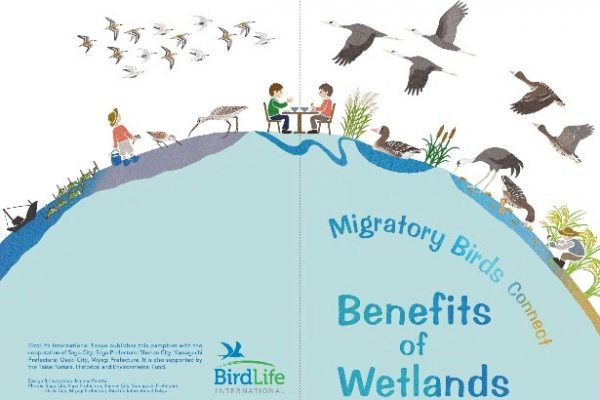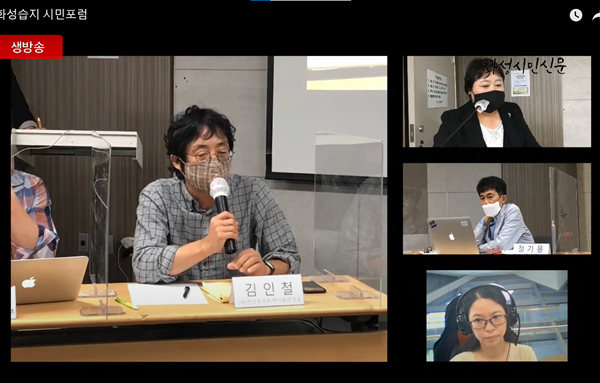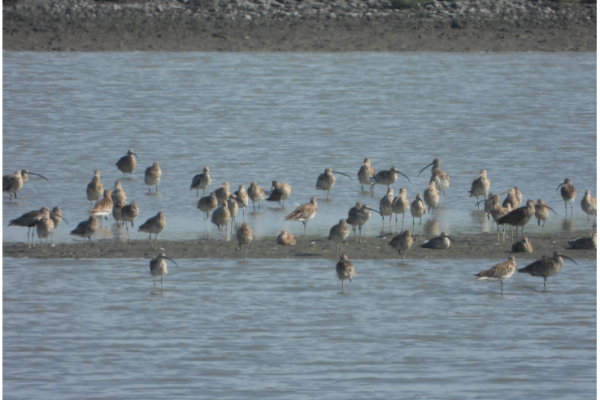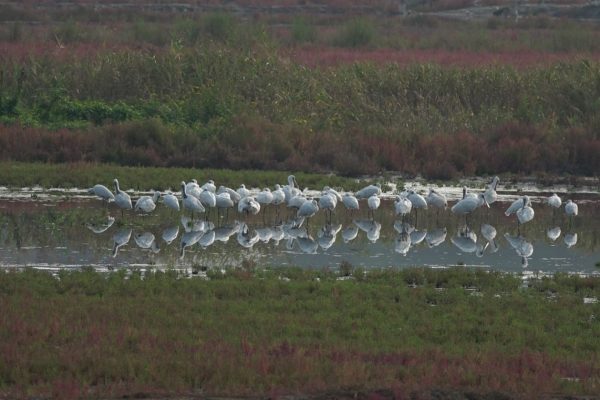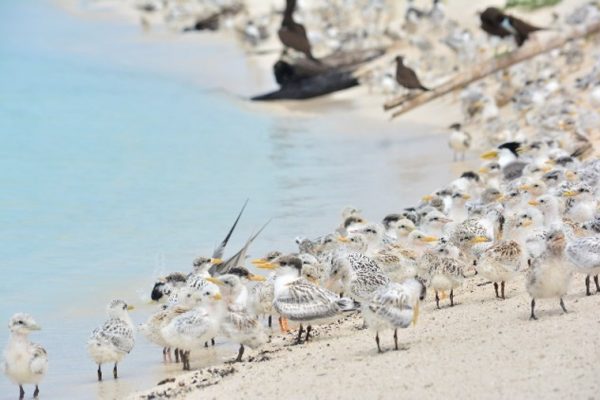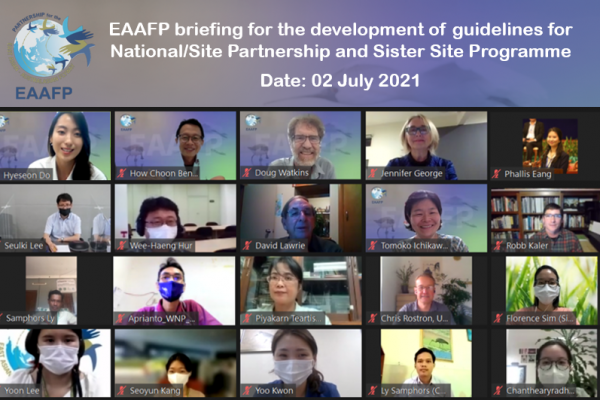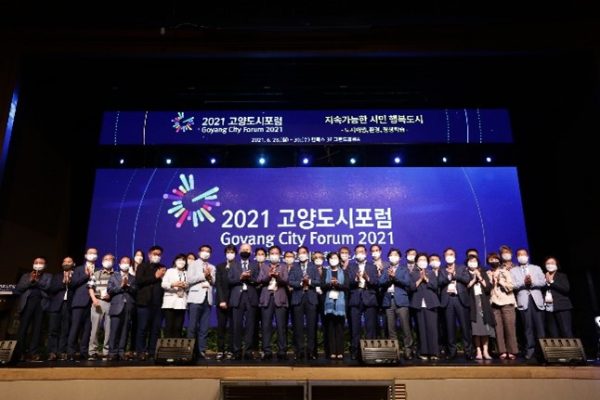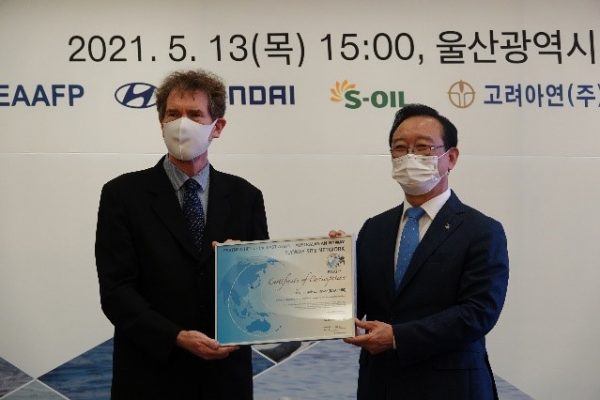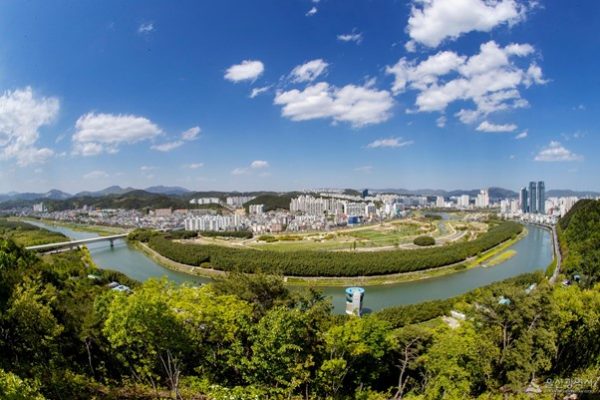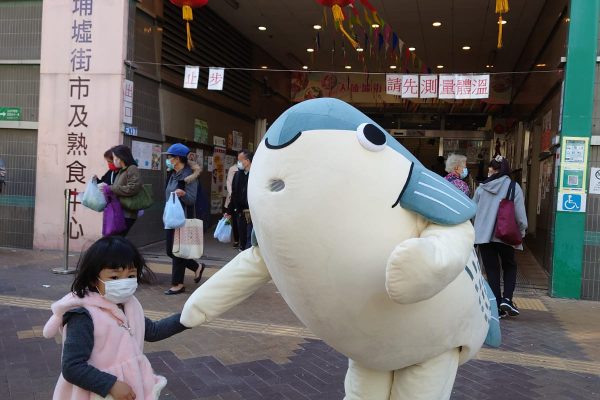-
Awareness raising event about the conservation of shorebirds was held at the Higashiyoka-higata Tidal Flat in Saga City, Japan.
The Higashiyoka-higata Tidal Flat (EAAF124) in Saga City, Saga Prefecture, is one of the most important habitats for shorebirds in Japan, and is designated as a Flyway Network Site…
Continue reading -
Hwaseong Wetland Civic Forum 2021 in Ro Korea
Under the project of ‘Collaboration for the Conservation of the Hwaseong Wetlands 2021’, the EAAFP Secretariat has been collaborating with the Korean Federation for Environmental Movement (KFEM) of Hwaseong…
Continue reading -
-
2021 National Monitoring of Black-faced Spoonbill in Ro Korea
Black-faced Spoonbill National Monitoring at the Hwaseong Wetlands ⓒ Yunjoo Cho/EAAFP Since 2020, the EAAFP Secretariat has…
Continue reading -
EAAFP Small Grant Fund project: 2021 Tubbataha Seabird Survey, Philippines
Seabirds spend their entire life in the open ocean, hence, they are a good indicator of coral reef health. Their nutrient-rich droppings fertilize roosting grounds and the surrounding water to the benefit of other marine life. Seabirds are one of the most highly threatened species of animals. Although they have a relatively long life span, they breed much slower and have fewer offspring than other birds in general. Partly supported by EAAFP Small Grant Fund for Working Groups and Task Forces, this year, the Tubbataha Management Office (TMO) use seabirds as an indicator to assess of how well – or how badly – the site are conserving Tubbataha Reefs Natural Park, A Flyway Network Site (EAAF 123) in the Philippines. We monitored the population of the seven species that breed in the Park, the: Red-footed Booby (Sula sula), Brown Booby (Sula leucogaster), Masked Booby (Sula dactylatra), Great Crested Tern (Thalasseus bergii), Sooty Tern (Onychoprion fuscata), Brown Noddy (Anous stolidus), and endemic Black Noddy subspecies (Anous minutus worcesteri). We use various monitoring methods and integrate results for a more accurate estimate of the populations. Distance counts are conducted once a month, while direct counts are done once a quarter. In-flight counts are done late in the afternoon, and dawn counts are made before the birds leave the islet to forage for food. When called for, we would do night counts of birds that come to roost after sundown. Adults, subadults, juveniles, pullus, eggs, and nests of each species are counted. Two teams conduct the count of the various species in various life stages. In all, it took a total of 39 teams to complete the survey. In May each year, we join the marine park rangers (MPR) for quarterly monitoring. The Covid 19 situation interposed several complications that delayed our trip, with interesting results. Together with WWF-Philippines staff, and volunteers, we were finally able to set sail on 2 June 2021. This year’s survey was funded by the East Asian-Australasian Flyway Partnership (EAAFP), Department of Environment and Natural Resources (DENR), and Pilipinas Shell Foundation, Inc. (PSFI). Report of the surveys will be shared by the end of 2021. Tubbataha Reefs Natural Park is both a Ramsar site and a Flyway Network Site of the EAAFP. Located 92 nautical miles southeast of Palawan, it is a 97,030-hectare marine protected area which was established on 11 August 1988. It is the largest no-take marine protected area in the Philippines. Its two islets are among the last known safe breeding habitats of seabirds in Southeast Asia. Article prepared by Tubbataha Management Office. The Tubbataha Reefs Natural Park is in the middle of the Sulu Sea. It is composed of two atolls and a reef. The Bird Islet is in the North Atoll and the smaller South Islet is located in the South Atoll. Marine park rangers construct the ‘Tubbataha Hilton’, our shelter from the sweltering heat in Bird Islet. Photo © Segundo Conales Jr Our team from Puerto Princesa City met with MPRs at the ranger station upon arrival. Research Officer Retch Alaba gave a briefing on the work at hand and assigned tasks for each person. Photo © Rowell Alarcon Our first task before setting foot on the islets was to do a distance count. Park Ranger Jeffrey David (in blue) leads the count in Bird Islet, where 80% of the total seabird population of Tubbataha reside. Photo © Rowell Alarcon In the following days, the teams got busy with their respective tasks. Here, one group counts the eggs of the Great Crested Tern. Photo © Kymry Delijero Showing off their EAAFP hats, Angelique Songco and Rowell Alarcon count Brown Noddies. Photo © Kymry Delijero Marine Park Ranger Segundo Conales Jr., (with umbrella) counts the eggs, nests, and adults of Black Noddy in the structure while John Eric Magbanua, Bantay Dagat of Local Government of Cagayancillo (LGU), serves as recorder. Photo © Retch Alaba From left: MPR Noel Bundal, SN2 Paul Balonsay PN, and Joan Pecson, WWF-Philippines, start the in-flight count at 4:30, when birds begin to arrive from the day’s foraging. Photo © Kymry Delijero The team doing a night count of the Sooty Tern population that landed after sundown. The estimate was 6000 individuals! Photo © Kymry Delijero From left to right: Marine Park Rangers Segundo Conales Jr, SNDP Paul Balonsay PN, SN2 Francis Lim and Noel Bundal (in blue shirt) with tallies their day’s count in the native dining table inside our hut. Photo © Kymry Delijero We observed lesser seabirds, probably because we arrived at the end of the breeding season when most of the adults have left. We also counted lesser eggs because most of the birds were already in the pullus or juvenile stages. Photo © Kymry Delijero Black Noddies continue to occupy the artificial nesting structures we built in 2017. Last year, we added new structures made of PVC and steel pipes (above), which are designed to last longer. Photo © Gerlie Gedoria We planted saplings of native trees in the islet in 2020 but most did not survive. Marine Park Rangers Amado Cayabo (LGU) and Cris Caranay (TMO) construct bamboo guards around a sapling so birds would not build their nests on the saplings and use their leaves as nesting materials. Photo © Kymry Delijero The only known breeding Masked Booby in Philippines lain an egg for the fourth time (!) since 2019. A second egg appeared a week later. Photo © Retch Alaba We used the WWF-Philippines research vessel, M/Y Navorca for the survey. Here, the team disembarks for the survey in South Islet. Photo © Rowell Alarcon This year's seabird survey team. Photo © Rowell Alarcon
Continue reading -
1st EAAFP briefing for the development of guidelines for National/Site Partnership and Sister Site Programme
1st Webinar Group Photo ©EAAFP Secretariat Starting with the speech of Mr. Robert Kaler, the Chair of EAAFP, the first webinar for Briefing on Development of Guideline/Recommendation for Site and National Partnership and Sister Site Programme was held on 2 July, 2021. Following the Decision 8 and Decision 9 at EAAFP MOP10, the Secretariat has been working with Ms. Jennifer George, project consultant to develop the guidelines strategically and efficiently. It will improve the 1,060 EAAFP FNS relationship among and beyond the network. The following Partners of EAAFP participated in the webinar: 5 Government Partners: Japan, Singapore, RO Korea, United States, Thailand 2 NGOs: New Zealand Miranda Trust and WWT 2 IGOs: ACB and Birdlife (Cambodia) 2 Site Managers from Indonesia Ms. George shared the background and expected outcomes through the guideline development. She highlighted that the FNS flows from relationships, hence securing and strengthening relationships within and between countries is the main purpose of this project. As 1,060 sites are crucial to migratory waterbirds, EAA Flyway holds 149 of those sites which some are twinned as Sister Sites. Ms. George shared the key terms of the guideline: Site Partnership (SP) National Partnership (NP) Sister Site Programs (SSP) Two case studies were presented to share the National Partnership in Japan, and strong Sister Site programs in Singapore. Ms. Tomoko Ichikawa (Presentation file), Ministry of Environment of Japan shared the 3 national networks (Anatidae, Shorebird, Crane), the structure of the NP, and the ongoing meetings in Japan. First, to strengthen cooperation among the Sites, she mentioned that each FNS in Japan belongs to 1 or more of the national networks. Second, she introduced the structure of the NP, where MOE-J carries out activities of the network in coordination with associated organizations. As well as coordinators of each species group network plays a key role publishing newsletters, forming mailing lists, creating Facebook page etc. to exchange information across the national FNS. She highlighted the many meetings well facilitated in Japan, such as the shorebird virtual meeting, the national CEPA WG meeting, the national liaison meeting, and workshops for FNS managers. The effort to share necessary information, encourage and support issues and discussions, and strengthen a cooperative relationship among site managers, local government and NGO all contributes to the excellent NP structure in Japan. Following are some key elements Ms. Ichikawa suggested for a NP: Network species group works well in mobilizing people for active participation and enthusiasm Coordinating cooperative activities Involvement of NGO to secure continuation on past achievements and the implementation of conservation works in the FNS Obtain the understanding of stakeholders by publishing CEPA materials Ms. Ichikawa further proposed some elements for the guideline: Changing the wording from ‘guideline’ to ‘guidance’ or ‘non-binding guideline’ Avoid too detailed and restrictive guideline as establishing a NP depends on the social condition and national stakeholders Highlighting the benefits of a NP The next case study was Mr. How Choon Beng (Presentation link) from National Parks Board, Singapore shared the Sister Site Programs. Sungei Buloh Wetland Reserve at the center of EAAF requires strong justification to secure the space for birds. Mr. How shared Singapore’s approach of regarding the entire population as the stakeholders. Hence, a shared understanding for the stakeholders to view the site as a national heritage, and a habitat for migratory waterbirds is essential. In support of this, Singapore encourages many programs to connect the people, and to enhance the 4 major MOU with China, Hong Kong, Malaysia and RO Korea. The MOU activities diversifies from school exchange, cross promoting other international sites as a tourist spot etc. As well as the MOU expands from sites to various institutions such as National Institute of Ecology, which Singapore held the 1st EAAF Shorebird Science meeting. Mr. How shared the key benefits of exchanging relationship opportunities, such as increasing research opportunities and sharing capacity building. Hence, the following suggestions were made for the SS Program: Strengthening research and management for capacity building Building target groups Utilizing technology to overcome travel and funding barriers Enhancing promotion and publicity Then the panel and open discussion was facilitated by Mr. Doug Watkins, the Chief Executive of EAAFP Secretariat. Mr. Watkins focused the discussion on three points: Defining the term “National Partnership” How to build relationships with other FNS on the Flyway How to develop more Sister Sites A question was raised by Dr. Piyakarn Teartisup, Thailand government partner of EAAFP, with recommendations regarding twinning sites nationally or internationally. Mr. Watkins encouraged to identify common points for linkage such as shared common species. Ms. Ichikawa supported the idea of common species, as Japan’s NP implementation worked best through species group based. Nonetheless, she highlighted the challenge of language barrier, hence initiated the support needed both locally and internationally. Mr. How also shared that a lot of the decisions in linking a Site comes from informal meetings. Such as, during MOP when small group discussions open it gives an opportunity to hear specific issues, challenges, or preferences on other sites. Mr. Terry Townshend, an advisor to the Beijing government on biodiversity, suggested in support of public engagement “to link sites using tracking studies, where individual birds are named by local schools and tracked between sites.” Finally, Mr. Fnu Aprinto, site manager from Wasur National Park Indonesia, shared despite its desire in building a relationship with other FNS there is a limit in the capacity of initiating this as all decision making is done by the Ministry of Environment and Forestry, the central government. Mr. Watkins concluded the open and panel discussion that the EAAFP Secretariat encourages the flexibility of the guideline and supports building strong relationship among sites by capturing he human elements on the shared biodiversity. Hence, in moving forward to articulate an effective and strategic guideline, he welcomed Partner’s suggestions in more depth through interviews that would be arranged by the Secretariat. EAAFP Partners can reach out to us through the contact information here: Ms. Jennifer George, Project consultant: jennifer@snapdragon.co.nz EAAFP Secretariat: secretariat@eaaflyway.net 1st Webinar video recording: Proposed Timeline:
Continue reading -
2021 Goyang City Forum, Ro Korea
The 2021 Goyang City Forum, following the first forum in 2019, was launched under the theme, ‘A Sustainable City for Citizen’s Happiness.’ The 3-day event…
Continue reading -
Welcome Ulsan Taehwa River in the Republic of Korea as the new EAAFP Flyway Network Site
On 13th May, 2021, the EAAFP welcomed the Taehwa River in Ulsan Metropolitan City of Republic of Korea as EAAFP 150th Flyway Network Site (FNS) and as 17th FNS…
Continue reading -
Promoting the wise use of artificial wetland – fishponds in Hong Kong
Conserving the natural habitats is the priority for conservation in the field, but at sites where habitats had been modified and degraded, we should promote the restoration and wise…
Continue reading

